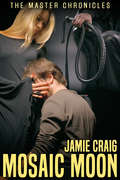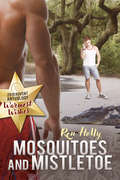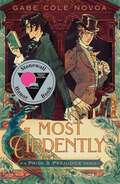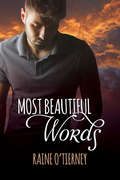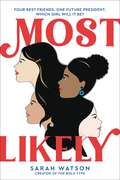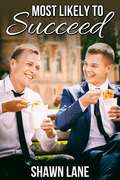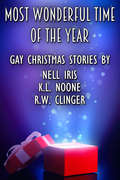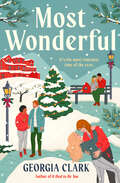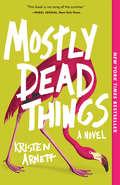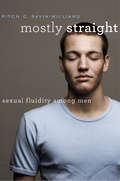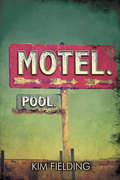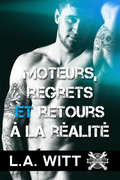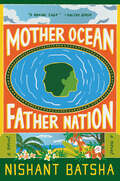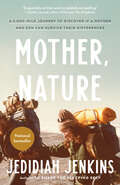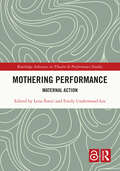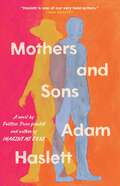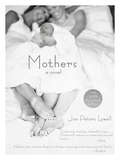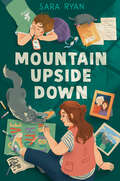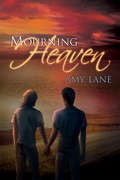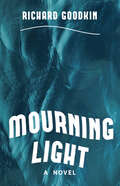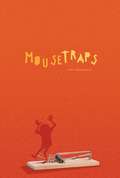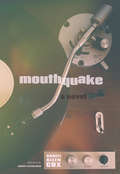- Table View
- List View
Mosaic Moon: The Master Chronicles, Book Iii (Master Chronicles #3)
by Jamie CraigBorn with the ability to read emotions, Emma Coolidge leads a life of self-imposed seclusion. Until she is saved by Gideon Keel and Jesse Madding, who befriend her and introduce her to people who can help her create a normal life. Everything is great but for one small problem. Emma longs to be more than friends with Gideon and Jesse, and wants to be part of their darker games involving bondage and sadism, but believes her desire can be nothing but a private fantasy.Gideon adores Jesse and wants nothing more than to give him everything he wants. When Gideon realizes Jesse wants Emma, as well, he decides to invite Emma into their games. But first Jesse and Gideon are forced to investigate a string of grave desecrations. They must unravel the mystery of who is stealing Black John's power, why, and how to reverse it before they can devote their time and energy to their mutual desire for a third in their bed.
Mosquitoes and Mistletoe (2018 Advent Calendar - Warmest Wishes)
by Ren HollyAfter Andrew’s boyfriend dumps him just before Christmas, he decides to take a job far, far away from city life. It’s a dishwashing job on a remote island off the coast of Georgia. Expecting sunshine, palm trees, and some quality alone time, Andrew is surprised to find alligators, mosquitoes, rattlesnakes, and Garrett—a devilishly handsome naturalist. Andrew desperately tries to resist Garrett’s charm, because a twice-broken heart before Christmas is just not an option. Besides Andrew’s new friend Anna might already have a thing for Garrett. But where do Garrett’s interests lie, and will Andrew find out before he’s surprised by a visit from his ex?A story from the Dreamspinner Press 2018 Advent Calendar "Warmest Wishes."
Most Ardently: A Pride & Prejudice Remix (Remixed Classics #9)
by Gabe Cole NovoaIn the Remixed Classics series, authors from marginalized backgrounds reinterpret classic works through their own cultural lens to subvert the overwhelming cishet, white, and male canon. This bittersweet Pride & Prejudice remix follows a trans boy yearning for the freedom to live openly, centering queerness in a well-known story of longing and subverting society’s patriarchal and cisheteronormative expectations. <p><p> London, 1812. Oliver Bennet feels trapped. Not just by the endless corsets, petticoats and skirts he's forced to wear on a daily basis, but also by society's expectations. The world—and the vast majority of his family and friends—think Oliver is a girl named Elizabeth. He is therefore expected to mingle at balls wearing a pretty dress, entertain suitors regardless of his interest in them, and ultimately become someone's wife. <p><p> But Oliver can't bear the thought of such a fate. He finds solace in the few times he can sneak out of his family's home and explore the city rightfully dressed as a young gentleman. It's during one such excursion when Oliver becomes acquainted with Darcy, a sulky young man who had been rude to "Elizabeth" at a recent social function. But in the comfort of being out of the public eye, Oliver comes to find that Darcy is actually a sweet, intelligent boy with a warm heart. And not to mention incredibly attractive. <p><p> As Oliver is able to spend more time as his true self, often with Darcy, part of him dares begin to hope that his dream of love and life as a man could be possible. But suitors are growing bolder—and even threatening—and his mother is growing more desperate to see him settled into an engagement. Oliver will have to choose: Settle for safety, security, and a life of pretending to be something he's not, or risk it all for a slim chance at freedom, love, and a life that can be truly, honestly his own. <p> <b>New York Times Bestseller</b>
Most Beautiful Words
by Raine O'TierneyTwelve-year-old Autumn's world is shattered when her beloved Great-Pop, Tommy Johnson, suffers a stroke that leaves him comatose. With everyone around her resigning themselves to the inevitable, Autumn is the only one not willing to give up. She and Great-Pop have more secret stories to share with each other, after all. More stories about Roy McMillan--the great love of Tommy's life whom he lost fifty years ago. Autumn struggles to keep Great-Pop on this side of death's door. But how can she compete with the beautiful and mysterious Valley--a place of surreal magic where the sun never fully sets? Especially when there's someone familiar in the Valley who will do everything he can to keep Great-Pop from returning to her.2015 Rainbow AwardsBest Gay Fantasy RomanceBest Gay Debut Best Gay Book Runner-Up
Most Likely
by Sarah WatsonFrom the creator of the hit TV series The Bold Type comes an empowering and heartfelt novel about a future female president's senior year of high school. Ava, CJ, Jordan, and Martha (listed in alphabetical order out of fairness) have been friends since kindergarten. Now they're in their senior year, facing their biggest fears about growing up and growing apart. But there's more than just college on the horizon. One of these girls is destined to become the president of the United States. The mystery, of course, is which girl gets the gig. Is it Ava, the picture-perfect artist who's secretly struggling to figure out where she belongs? Or could it be CJ, the one who's got everything figured out...except how to fix her terrible SAT scores? Maybe it's Jordan, the group's resident journalist, who knows she's ready for more than their small Ohio suburb can offer. And don't overlook Martha, who will have to overcome all the obstacles that stand in the way of her dreams. This is the story of four best friends who have one another's backs through every new love, breakup, stumble, and success--proving that great friendships can help young women achieve anything...even a seat in the Oval Office.
Most Likely to Succeed
by Shawn LaneThomas Harrigan can't help but admire his sexy, single, and openly gay boss, Clark Sterling. He never expects the gorgeous lawyer to be interested in him. But when Clark makes his interest shockingly clear, Thomas find himself involved with the enigmatic man.Burned before by a disastrous office romance, Clark knows he should keep his relationship with Thomas professional. But there’s something disarmingly genuine about Thomas that Clark can’t resist.The more time Thomas spends in Clark’s company and bed, the more he knows he is falling in love with Clark. But when Thomas’s resume finds its way to a rival firm, owned by the very man who hurt Clark before, Clark cuts Thomas out of his life leaving Thomas wondering if he really is the most likely to succeed.
Most Wonderful Time of the Year
by Nell IrisJMS Books' Trios are themed collections of three gay romance stories by a trio of authors. Each story is available separately, but readers can get all three for a discounted bundle price.Most Wonderful Time of the Year contains three contemporary M/M holiday romances just in time for Christmas! Contains the stories:Four Christmases by Nell Iris: Will a decade-old family feud and long held secrets stand in the way of love? Auden looks for peace and quiet when he meets Porter who’s nothing like Auden expected. A moment shared begins a surprising liaison. As their relationship deepens, Auden worries that the conflict between their two families will come between them. Can the holiday spirit help them find their happily ever after?Gingerbread Dreams by K.L. Noone: Nate’s never entered a televised baking competition before. He’s good at gingerbread and adores the holidays. But one judge has a reputation for ice-cold critiques. Marcus demands perfection. Audiences love it, but he’s tired of being the bad guy. And Nate’s ginger treats make him want more. But they’ll have to resist temptation during the competition to achieve their Gingerbread Dreams ... Keeping Up with the Icicles by R.W. Clinger: Jonah Icicle and his boyfriend Sandy travel to Lake Erie to spend Christmas with Jonah’s family. But his pushy mother has a special gift for him: his ex-boyfriend, NFL quarterback Ricky, is in town and will be spending the holidays with them! Worse, she wants him to dump Sandy and marry the quarterback. Jonah finds himself torn between the two men. Which boyfriend will it be, new or old?
Most Wonderful: A Christmas Novel
by Georgia ClarkIt&’s the most romantic time of the year. Three adult siblings, each at a personal and romantic crossroads, reunite with their larger-than-life mother at her Catskills manor for an unforgettable Christmas in &“the funny queer holiday rom-com [we&’ve] always wanted to read&” (Self).&“Perfectly captures the glimmering magic of love at the holidays.&”—Christina Lauren, New York Times bestselling author of The UnhoneymoonersThe holidays are fast approaching, and the Belvedere siblings are a mess. Liz, a Hollywood showrunner and responsible eldest, has no idea how to follow up her hit show&’s first season, or how to deal with her giant crush on its star, Violet Grace. Birdie turned her chronic middle-child syndrome into a career as a stand-up comic, but since she spends more time wooing women than working on new material, she&’s facing one-hit-wonder status, especially once she gets axed by her manager. And Rafi, sensitive romantic and the baby golden boy, proposes to his co-worker girlfriend in front of their entire company, only to be turned down by the woman he thought was the love of his life.Born to three different fathers, the three adult children share one mother: famed actress and singer Babs Belvedere. Seeking direction and holiday cheer, all three siblings head up to their mother&’s house in the country, determined to swear off love and focus on themselves and their work. But the spirit of the season seems to have different plans for them, and their best intentions are quickly derailed in the most delightful and festive of ways.Emotional, smart, and sexy, this queer holiday rom-com celebrates love, family, and the wild creative life―perfect for fans of Emily Henry and Casey McQuiston.
Mostly Dead Things: A Novel
by Kristen Arnett<P><P>One morning, Jessa-Lynn Morton walks into the family taxidermy shop to find that her father has committed suicide, right there on one of the metal tables. <P><P>Shocked and grieving, Jessa steps up to manage the failing business, while the rest of the Morton family crumbles. Her mother starts sneaking into the shop to make aggressively lewd art with the taxidermied animals. Her brother Milo withdraws, struggling to function. And Brynn, Milo’s wife—and the only person Jessa’s ever been in love with—walks out without a word. <P><P>As Jessa seeks out less-than-legal ways of generating income, her mother’s art escalates—picture a figure of her dead husband and a stuffed buffalo in an uncomfortably sexual pose—and the Mortons reach a tipping point. For the first time, Jessa has no choice but to learn who these people truly are, and ultimately how she fits alongside them. <P><P> Kristen Arnett’s debut novel is a darkly funny, heart-wrenching, and eccentric look at loss and love. <P><b>A New York Times Bestseller</b>
Mostly Straight: Sexual Fluidity among Men
by Ritch C. Savin-WilliamsA growing number of young men today say they are “mostly straight” and yet feel a slight but enduring desire for men. Ritch Savin-Williams explores the stories of 40 mostly straight young men to help us understand the biological, psychological, and cultural forces that are loosening the sexual bind many boys and young men experience.
Motel. Pool.
by Kim FieldingIn the mid-1950s, Jack Dayton flees his working-class prospects in Omaha and heads to Hollywood, convinced he'll be the next James Dean. But sleazy casting couches don't earn him stardom, and despair leads to a series of poor decisions that ultimately find him at a cheap motel off Route 66, lifeless at the bottom of the pool. Sixty years later, Tag Manning, feeling hopeless and empty, flees his most recent relationship mistake and takes to the open road. On a roundabout route to Las Vegas, he pulls over to rest at an isolated spot on Route 66. There's no longer a motel or pool, but when Tag resumes his journey to Vegas, he finds he's transporting a hitchhiking ghost. Jack and Tag come to find much-needed friends in each other, but one man is a phantom and the other is strangely cursed. Time is running out for each of them, and they must face the fact that a future together may not only be a gamble... it may not be in the cards.
Moteurs, regrets et retours à la réalité (La guerre des moteurs #3)
by L. A. Witt Cassie BlackLa guerre des moteurs, numéro hors sérieQuand le garage de Reggie prend part à une émission de télé-réalité célèbre, les affaires marchent mieux que jamais. Et remettre les finances du garage du bon côté du zéro vaut bien la peine de s’enfoncer dans les machinations de la chaîne. Face aux faibles audiences de l’émission, Wes, producteur, est désigné pour proposer un nouveau spin-off à Reggie. Le mécanicien sexy le fait déjà transpirer en temps normal, mais cette fois, Wes ne peut pas tout dire. Avec les producteurs sur son dos, il est censé présenter une émission que Reggie n’acceptera jamais, même si son refus signait la fin de sa participation à La Guerre des Moteurs. Et la chaîne compte bien sur le refus de Reggie. Mais ils ne s’attendaient pas à ce que leur messager tombe sous le charme de l’homme qu’ils tentent de renvoyer.
Mother Ocean Father Nation: A Novel
by Nishant BatshaA riveting, tender debut novel, following a brother and sister whose paths diverge—one forced to leave, one left behind—in the wake of a nationalist coup in the South PacificOn a small Pacific island, a brother and sister tune in to a breaking news radio bulletin. It is 1985, and an Indian grocer has just been attacked by nativists aligned with the recent military coup. Now, fear and shock are rippling through the island’s deeply-rooted Indian community as racial tensions rise to the brink.Bhumi hears this news from her locked-down dorm room in the capital city. She is the ambitious, intellectual standout of the family—the one destined for success. But when her friendship with the daughter of a prominent government official becomes a liability, she must flee her unstable home for California.Jaipal feels like the unnoticed, unremarkable sibling, always left to fend for himself. He is stuck working in the family store, avoiding their father’s wrath, with nothing but his hidden desires to distract him. Desperate for money and connection, he seizes a sudden opportunity to take his life into his own hands for the first time. But his decision may leave him vulnerable to the island’s escalating volatility.Spanning from the lush terrain of the South Pacific to the golden hills of San Francisco, Mother Ocean Father Nation is an entrancing debut about how one family, at the mercy of a nation broken by legacies of power and oppression, forges a path to find a home once again.
Mother, Nature: A 5,000-Mile Journey to Discover if a Mother and Son Can Survive Their Differences
by Jedidiah JenkinsFrom New York Times bestselling author of To Shake the Sleeping Self. &“Exquisitely written and completely compelling . . . As Jedidiah Jenkins traces a 5,000-mile route with his wildly entertaining mother, Barb, he begins to untangle the live wires of a parent-child bond and to wrestle with a love that hurts.&”—Suleika Jaouad, author of Between Two Kingdoms When his mother, Barbara, turns seventy, Jedidiah Jenkins is reminded of a sobering truth: Our parents won&’t live forever. For years, he and Barbara have talked about taking a trip together, just the two of them. They disagree about politics, about God, about the project of society—disagreements that hurt. But they love thrift stores, they love eating at diners, they love true crime, and they love each other. Jedidiah wants to step into Barbara&’s world and get to know her in a way that occasional visits haven&’t allowed. They land on an idea: to retrace the thousands of miles Barbara trekked with Jedidiah&’s father, travel writer Peter Jenkins, as part of the Walk Across America book trilogy that became a sensation in the 1970s. Beginning in New Orleans, they set off for the Oregon coast, listening to podcasts about outlaws and cult leaders—the only media they can agree on—while reliving the journey that changed Barbara&’s life. Jedidiah discovers who Barbara was as a thirty-year-old writer walking across America and who she is now, as a parent who loves her son yet holds on to a version of faith that sees his sexuality as a sin. Along the way, he peels back the layers of questions millions are asking today: How do we stay in relationship when it hurts? When do boundaries turn into separation? When do we stand up for ourselves, and when do we let it go? Tender, smart, and profound, Mother, Nature is a story of a remarkable mother-son bond and a moving meditation on the complexities of love.
Mothering Performance: Maternal Action (Routledge Advances in Theatre & Performance Studies)
by Lena Šimić Emily Underwood-LeeMothering Performance is a combination of scholarly essays and creative responses which focus on maternal performance and its applications from a variety of interdisciplinary perspectives. This collection extends the concept and action of ‘performance’ and connects it to the idea of ‘mothering’ as activity. Mothering, as a form of doing, is a site of never-ending political and personal production; it is situated in a specific place, and it is undertaken by specific bodies, marked by experience and context. The authors explore the potential of a maternal sensibility to move us towards maternal action that is explicitly political, ethical, and in relation to our others. Presented in three sections, Exchange, Practice, and Solidarity, the book includes international contributions from scholars and artists covering topics including ecology, migration, race, class, history, incarceration, mental health, domestic violence, intergenerational exchange, childcare, and peacebuilding. The collection gathers diverse maternal performance practices and methodologies which address aesthetics, dramaturgy, activism, pregnancy, everyday mothering, and menopause. The book is a great read for artists, maternal health and care professionals, and scholars. Researchers with an interest in feminist performance and motherhood, within the disciplines of performance studies, maternal studies, and women’s studies, and all those who wish to gain a deeper understanding of maternal experience, will find much of interest.
Mothers and Sons: A Novel
by Adam HaslettA mother and son, estranged for years, must grapple with the shared secret that drove their lives apart in this enthralling story about family, forgiveness, and how a fleeting act of violence can change a life forever, by "one of the country's most talented writers" (Wall Street Journal) At forty, Peter, an asylum lawyer in New York City, is overworked and isolated. He spends his days immersed in the struggles of immigrants only to return to an empty apartment and occasional hook-ups with a man who wants more than Peter can give. But when the asylum case of a young gay man pierces Peter's numbness, the event that he has avoided for twenty years returns to haunt him. Ann, his mother, who runs a women's retreat center she founded after leaving his father, is hurt by the estrangement from Peter but cherishes the world she has built. She long ago put behind her the decision that divided her from her son. But as Peter&’s case plunges him further into the fraught memory of his first love and the night of violence that changed his life, he and his mother must confront the secret that tore them apart. With unsurpassed emotional depth, Mothers and Sons reveals all that is lost by looking away from the past and the love that might be restored by facing it. In his spellbinding new novel, Adam Haslett demonstrates yet again his mastery of &“a rich assortment of literary gifts&” (New York Times).
Mothers: A Novel
by Jax Peters LowellIt would be hard to imagine parents more perfect than Claire and Theo. In the mid-l960s, in a rambling apartment overlooking Central Park West, they raise their son Willy with enthusiasm, encouragement, and with what might today be called unconditional love. It might also be called unconventional love, for both Claire and Theo are women. They are Willy's mothers and until a mistrustful outside world intrudes to try to tear them apart, they are the best family a boy could want. In an enchanting, moving novel, Jax Peters Lowell explores the powerful bonds of love and family and gives us a cautionary tale for our own times."Poignant, delicate, and assured, this is a book to go to Brooklyn for." -- Publishers Weekly"The fantasy and mythic weight of a fairy tale." -- Kirkus Reviews"Compelling, good social medicine." -- San Francisco Chronicle
Motorcycle Man
by Sarah Hadley BrookMotorcycle shop owner Ben Makowski offers a three-day class for new riders. When he finds out one of his students doesn’t even like motorcycles, he’s irritated but drawn to the man at the same time. Though he can clearly see the new student is dealing with something difficult, Ben sets out to get to know what that might be and if he can help in any way.Writer Angus Winter’s publisher has insisted he learn about motorcycles for an upcoming book, which is the last thing he wants to do. His fear of motorcycles stems from a tragedy in his past. But something about his sexy new teacher makes him want to open up to the man. Can Angus trust Ben with the burden he’s carried for so long?
Mountain Upside Down
by Sara RyanA funny and heartfelt LGBTQIA+ middle grade novel set against the backdrop of family drama and a library funding campaign in a small town.Alex Eager lives in Faillin, OR with her grandmother, a retired librarian. Life should be great for Alex, since she finally worked up the courage to ask her best friend PJ if they could be more than friends and she said yes. But their new relationship will have to be long distance, because PJ is moving. On top of that, Alex is worried that something is wrong with her increasingly forgetful grandmother. And to make matters worse, Faillin is holding a referendum on library funding, and things aren&’t looking good. Will anything good for Alex ever last?Mountain Upside Down is a beautifully crafted story of a thirteen-year-old girl finding her place in her family and her community. It&’s a queer-positive story that doesn&’t center coming out. It&’s a story of a library&’s role in a community that doesn&’t feature book banning. And it&’s a story of long-held family secrets and resentment that focuses not on final resolution but learning how to communicate again.
Mourning Heaven
by Amy LaneHeroes fall. Peter first came to the tiny backwater of Daisy, California, as a child, and he was sure of one thing: his cousin Michael would take care of him. When Michael started a friendship with the fragile, haunted Bodi Kovacs, Peter's consolation in losing any claim to Bodi was that Michael would care for him too. But tragedy struck, and Michael ripped himself out of their world and threw away the people who loved him most. Six years later, Michael is coming home in a box. All it took to destroy a hero was a town full of bigotry and hatred. Reclaiming him will take strength of heart that neither Peter nor Bodi had six years ago. Since Michael left, Bodi has been lost and alone. Peter can try to make Bodi his and take the role Michael should have had, but first he and Bodi have to confront the past. They will need to face Michael, the good and the bad, the beauty and the sadness, and see his memory truly for what it was and not what it could have been. It's a simple act that may destroy them both: sifting through the flaming ruins of heaven is a sure way to annihilate a bleeding mortal heart. Winner in the 2013 Rainbow Awards. Third (tie): Best Gay NovelSecond (tie): Best Gay Contemporary Romance (William Neale Award)
Mourning Light
by Richard GoodkinSet in Madison, Wisconsin, and New Haven, Connecticut, in the early days of the AIDS epidemic, Mourning Light is a semi-autobiographical love story. Our narrator, Reb (so named by his mother because of her love of the Daphne du Maurier novel Rebecca), is hounded by guilt over the death of his lover, Anthony, which took place on the same day Reb first met the handsome yet enigmatic Eric. Once Reb becomes convinced that Anthony has sent him a cryptic message from beyond the grave, he becomes obsessed with figuring out what it could mean. Told in a series of flashbacks and remembrances, the novel concludes with a whirlwind of revelations that both complicate and resolve Reb’s view of his world and his lover.
Mourning Light
by Richard GoodkinSet in Madison, Wisconsin, and New Haven, Connecticut, in the early days of the AIDS epidemic, Mourning Light is a semi-autobiographical love story. Our narrator, Reb (so named by his mother because of her love of the Daphne du Maurier novel Rebecca), is hounded by guilt over the death of his lover, Anthony, which took place on the same day Reb first met the handsome yet enigmatic Eric. Once Reb becomes convinced that Anthony has sent him a cryptic message from beyond the grave, he becomes obsessed with figuring out what it could mean. Told in a series of flashbacks and remembrances, the novel concludes with a whirlwind of revelations that both complicate and resolve Reb’s view of his world and his lover.
Mousetraps
by Pat SchmatzBack in grade school, Maxie and Rick were best friends. Rick would design crazy inventions, and Maxie, the artistic one, would draw them. Then something terrible happened to Rick, and he vanished from her school and her life. Years later, he shows up at Maxie's high school. In some ways he's the same person she once knew. But in other ways--frightening ones--he's very, very different...
Mouthquake
by Sarah Schulman Daniel Allen CoxMontreal, 1979. A boy's speech starts to fracture along with the cement of le Stade olympique. Do they share a fault line? Daniel Allen Cox's unconventional fourth novel tells the story of a boy with a stutter who grows up and uses sound to remember the past. A coming-of-age tale that telescopes through time like an amnesiac memoir, Mouthquake finds its strange beat in subliminal messages hidden in skipping records, in the stutters of celebrities, and in the wisdom of The Grand Antonio, a suspicious mystic who helps the narrator unlock the secret to his speech. This is a loudly exclaimed book of innuendo, rumours, and the tangled barbs of repressed memory that asks: How do you handle a troubling past event that behaves like a barely audible whisper?Written with a poetic bravado and in a structure that mimics a stutter, the elegiac Mouthquake is speech therapy for the bent: the signal is perverted and the sounds are thrilling.Includes an afterword by Sarah Schulman, author of Rat Bohemia and The Gentrification of the Mind: Witness to a Lost Imagination.Daniel Allen Cox is the author of Shuck, Krakow Melt (both Lambda Award finalists), and Basement of Wolves. He also co-wrote Bruce LaBruce's film Gerontophilia, released in the US in 2015.
